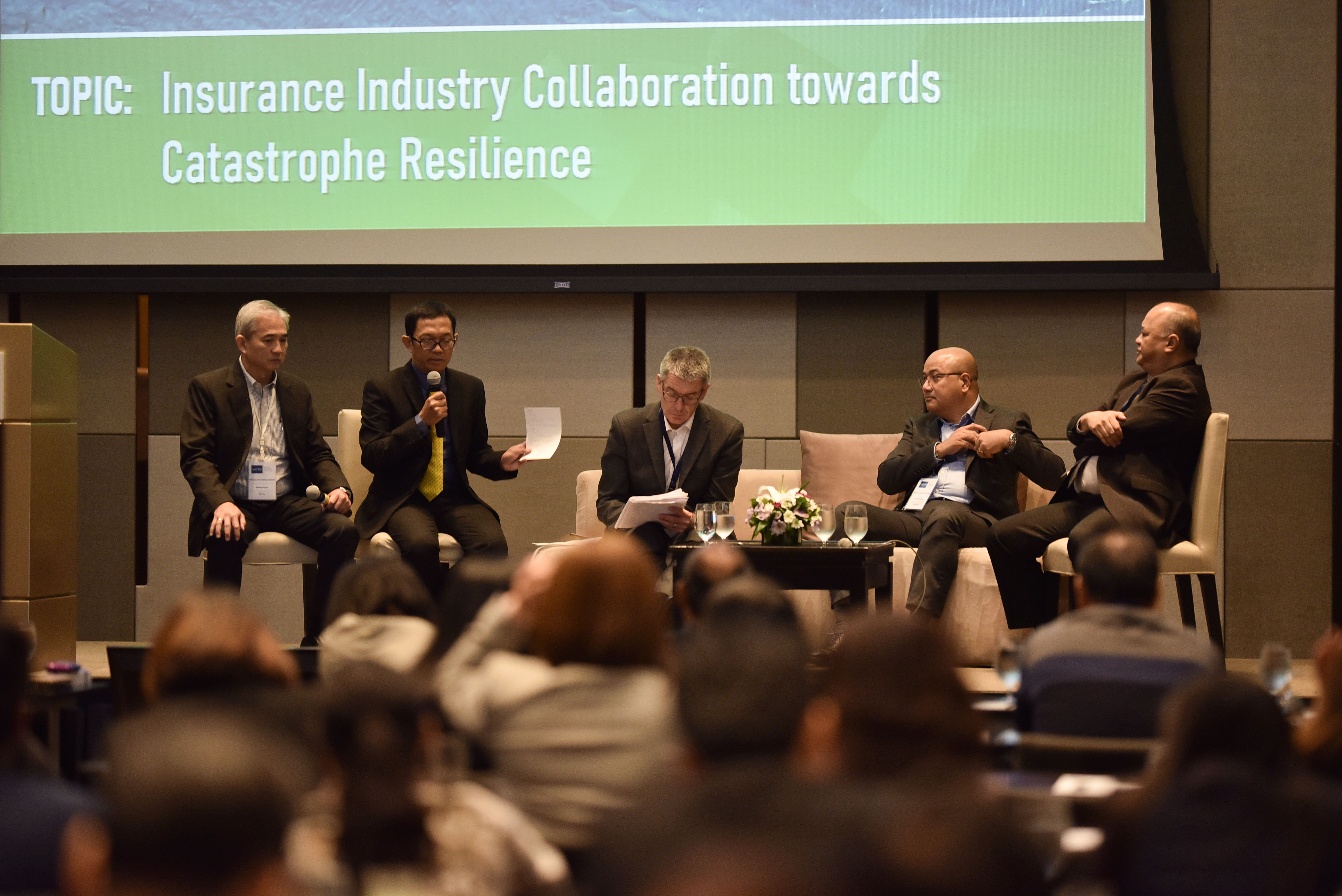Nat Re Hosts 5th Non-Life Annual Technical Forum on Catastrophe and Agriculture Insurance
The National Reinsurance Corporation of the Philippines (Nat Re) held its 5th Annual Technical Forum (ATF) for the non-life industry at the New World Hotel in Makati City, Philippines. With the theme “Greater Disaster Resilience through Industry Cooperation”, the Forum convened industry experts to provide its attendees insights on new opportunities for non-life insurance in the Philippines. In attendance were CEOs and underwriters of Nat Re’s client companies, as well as representatives from the Insurance Commission, the Philippine Crop Insurance Corporation, the Asian Development Bank, the World Bank, and others.

Deputy Insurance Commissioner Erickson Balmes delivers the opening speech at the non-life ATF
Deputy Insurance Commissioner Erickson Balmes, in his opening remarks on behalf of Insurance Commissioner Dennis Funa, referred to managing catastrophe risks as the industry’s “collective responsibility” and as something that the Insurance Commission is always open to discussing with insurance players. One initiative proposed by the Philippine Insurers and Reinsurers Association (PIRA) and Nat Re is a catastrophe insurance facility, whose success, according to Balmes, is dependent on the support of the non-life insurers. He called on the industry to come out “more compact, united, and invigorated” after discussions in the ATF.
Lessons from MAIPARK’s success in catastrophe insurance
PT Reasuransi MAIPARK President Director Ahmad Fauzie Darwis and Technical Director Heddy Agus Pritasa delivered the first presentation on Maipark and catastrophe insurance in Indonesia.
Darwis set the tone of the session by stressing the need for a collaborative effort between the government and the private sector in handling catastrophic losses.
Pritasa recounted the experience in Indonesia—it was the 1999 Chi-Chi earthquake in Taiwan, along with the near-zero tariff rates for catastrophe insurance, that triggered the creation of a technical working group composed of representatives from the government and the private insurance industry. This group was tasked to study the creation of a specialized company that will best handle disaster risks. From there, a pool was developed.

Darwis (left) and Pritasa (right) say the key to Maipark’s success is its public-private partnership nature
The pool eventually evolved into Maipark which, Pritasa admitted, was met with some resistance from the industry. “This was because they were not aware at that time of what Maipark should be creating and because Maipark could take away some portion of the industry’s business,” Pritasa said. To address this, the reinsurer focused on spreading awareness on the main reason why the company was established in the first place—to provide reinsurance capacity and conduct research for the industry.
Pritasa delved into other details such as the market situation before and after the creation of Maipark, the provisions of their standard earthquake insurance policy, their cession scheme, and the use of their very own catastrophe models in research. He also discussed how Maipark even went on to provide the Indonesian financial services regulator the technical support in determining the earthquake tariff rates.
Pritasa emphasized that the key to Maipark’s success was, “simply, it is a PPP (public-private partnership),” among the founding fathers, the regulators, and the insurance industry.
Catastrophe insurance pool for greater financial resilience and insurers’ profitability
Mr. Matthew Foote, a Senior Financial Sector Specialist at the World Bank and a reactor to the main presentation, stressed that “data and knowledge competencies and awareness on how insurance actually works” are important when building strategies for effective risk transfer instruments. He also noted that resilience should also “account for better management of finances” and not just of physical structures.

Pritasa, Foote (center), Ramos (second from right), and Santos (rightmost) take questions from the audience and from the moderator Mr. Sandy Reyes (leftmost)
The second reactor Mr. Francisco Ramos, Executive Vice President at The Mercantile Insurance, said that insurers need to price risks in a way that will sustain their operations in the long term. He also noted that coverage against natural catastrophes in the Philippines are essentially given for free much like how it was in Indonesia in the 1990s.
The third reactor Mr. Alberto Santos, Business Director at BPI/MS, shed light on PIRA’s discussions on the creation of a catastrophe pool for the Philippines. He expressed that the industry should start with a simple scheme in order to get things moving.
The audience members agreed that creating a technical working group consisting of the Insurance Commission, the insurance industry, and the World Bank should be the next course of action.
Private insurers’ role in agriculture insurance development
Mr. Arup Chatterjee, Principal Financial Sector Specialist at the Asian Development Bank, began the ATF’s second session by describing the importance of agriculture for food security, economic development, and employment. He said that businesses such as financial technology companies have already begun to see opportunities in the rural sector and that “there is merit in the argument in terms of creating jobs and raising incomes” in agriculture.

Chatterjee on the importance of raising awareness on agriculture insurance: “Demonstration is the best publicity”
As to the role of insurers in this space, Chatterjee said insurance is one tool for governments to incentivize farmers to remain in the fields and contain other issues like migration to urban cities. He pointed out, however, that the insurance industry has challenges in penetrating the market due to the dynamic nature of the various agriculture risks and the need to consider the whole value chain of the agribusiness. Another issue is the lack of data at optimal resolutions, which are necessary for insurers to model and price risk.
“However, that doesn’t mean the insurance industry can shy away,” Chatterjee said. “Insurance has a role to play in this entire [agriculture] value chain ecosystem,” he added. He encouraged the industry to look into ways to make this case more compelling to policy makers and regulators.
Chatterjee described how partnerships with other organizations can allow insurance to provide farmers with greater access to formal financing. Referring to the case of how insurance provides liquidity to farmers and helps them repay their bank loans, he encouraged the industry to look into other financing solutions which they can develop in partnership with formal lending institutions. The speaker also put forward the idea of insurers partnering with farmer cooperatives with risk-sharing arrangements to provide them with reinsurance support.
Chatterjee stressed the need for governments to develop an appropriate framework for risk management which should also involve the farmers and the insurers. He went on to describe the types of agriculture insurance markets in the Asia-Pacific region and best practices in the United States, Turkey, and India. In some cases, he said, publicly implemented programs have been transformed to public-private partnerships.
Chaterjee wrapped up his presentation with key lessons from the experiences of other countries. He emphasized the need of support from the government, through other interventions beyond premium subsidies, and raising farmers’ awareness on matters such as policy wordings and claims filing. “Demonstration is the best publicity,” he said.
Public-private partnerships: Another approach to developing agri insurance
Mr. Manuel Cortina, Officer-in-Charge of the Business Development and Marketing Department at the Philippine Crop Insurance Corporation (PCIC) and a reactor to the main presentation, said that while agriculture insurance is a risky business, the PCIC is at an advantage as it operates nationwide. Mr. Michael Rellosa, Executive Director of PIRA, added that if insurers cover the entire value chain of agriculture they can diversify their risks further.
Mr. Noel Raboy, President and CEO of the insurance cooperative CLIMBS, said there is demand from their members for more agriculture insurance products. CLIMBS is in talks with the PCIC in developing products which, for instance, target certain crops vulnerable to typhoons and other ones vulnerable to pests.

Chatterjee, Rellosa (leftmost), Raboy (second from left), and Cortina (rightmost) take questions from the audience and from the moderator Nat Re Chief Underwriting Officer Mr. Christian Ladoux (center)
Cortina presumed that industry players are not inclined to sell parametric agriculture insurance because of the presence of basis risk. Chatterjee said public-private partnerships can address this and other issues by allowing insurers to develop their experience and history, have access to data, and, therefore, bring down their costs.
Rellosa mentioned that PIRA, Nat Re, the Asian Development Bank, and other partners have in fact been collaborating to get the private sector involved in insuring agriculture risks. He emphasized the need to garner support among the various stakeholders and mobilize political will for these plans to bear fruit.
